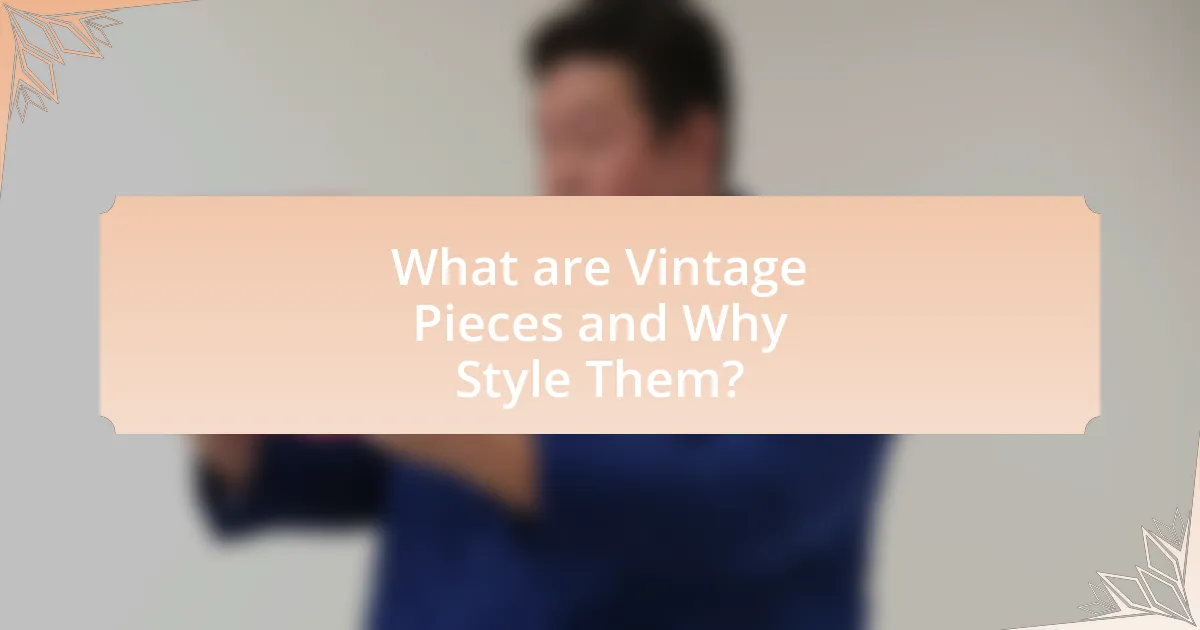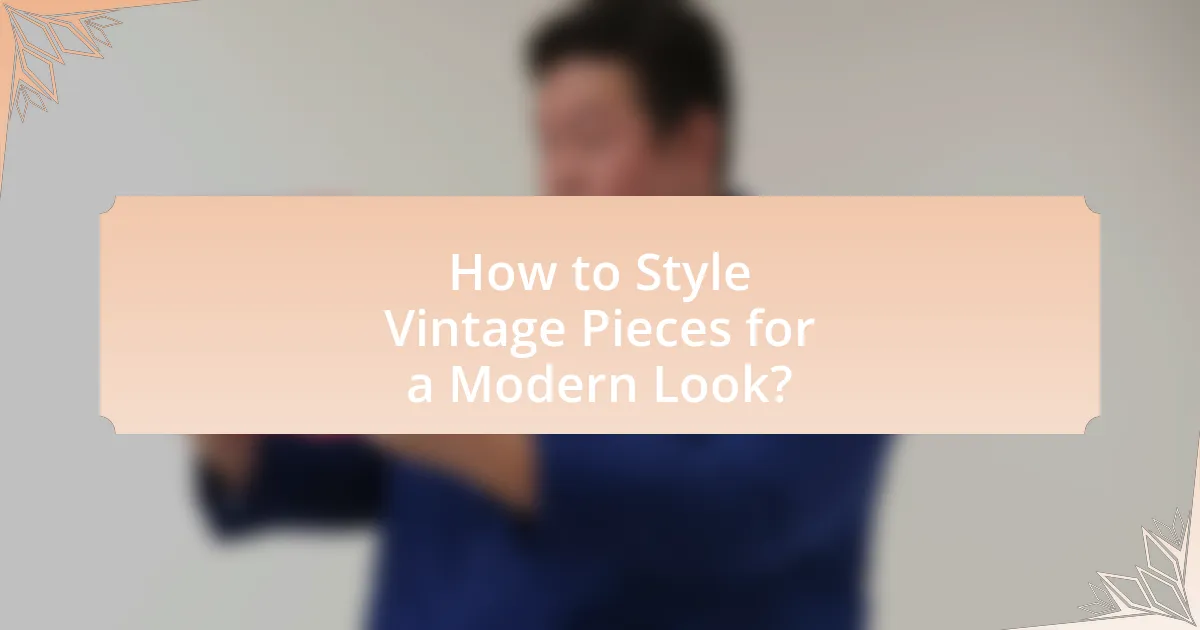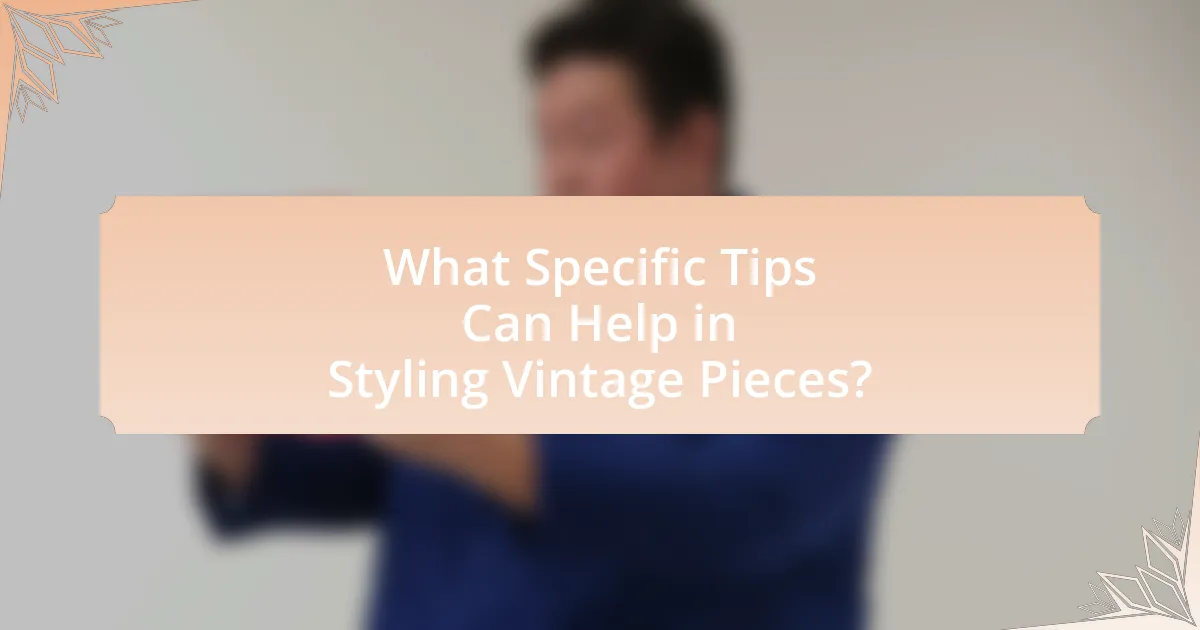The article focuses on the styling of vintage pieces, defined as items that are at least 20 years old and characterized by unique designs and craftsmanship. It explores the differences between vintage and modern fashion, highlighting the resurgence of vintage clothing driven by sustainability and individuality. Key topics include the benefits of incorporating vintage items into modern wardrobes, effective styling techniques, layering strategies, and the importance of accessories. Additionally, the article provides practical tips for maintaining vintage pieces and avoiding common styling mistakes, ensuring that vintage fashion remains relevant and appealing in contemporary settings.

What are Vintage Pieces and Why Style Them?
Vintage pieces are items that are at least 20 years old, often characterized by unique designs, craftsmanship, and historical significance. Styling vintage pieces is popular because they add individuality and character to modern outfits, allowing wearers to express personal style while also embracing sustainable fashion practices. The appeal of vintage items is supported by the fact that they often feature high-quality materials and timeless aesthetics, making them desirable in contemporary fashion.
How do vintage pieces differ from modern fashion?
Vintage pieces differ from modern fashion primarily in their design aesthetics and construction techniques. Vintage fashion often features unique patterns, fabrics, and silhouettes that reflect the cultural and historical context of the time period, such as the bold prints of the 1960s or the structured lines of the 1950s. In contrast, modern fashion tends to prioritize minimalism, functionality, and fast fashion trends, often utilizing synthetic materials and mass production methods. For example, vintage garments may be made from natural fibers like cotton or wool, while contemporary clothing frequently incorporates polyester and other blends. This distinction highlights how vintage pieces not only represent a different era but also embody the craftsmanship and values of their time.
What defines a vintage piece in fashion?
A vintage piece in fashion is defined as an item that is at least 20 years old and reflects the style and trends of its era. This classification is based on the historical context and the cultural significance of the garment, which often embodies the aesthetics and craftsmanship of the time it was produced. For example, clothing from the 1980s is considered vintage today, as it showcases the unique styles and materials popular during that decade.
Why is there a resurgence in vintage fashion today?
The resurgence in vintage fashion today is primarily driven by a growing consumer interest in sustainability and individuality. As awareness of fast fashion’s environmental impact increases, many consumers are turning to vintage clothing as a more sustainable alternative, reducing waste and promoting recycling. Additionally, vintage fashion allows individuals to express their unique style, as these pieces often feature distinctive designs that are not commonly found in contemporary collections. According to a 2021 report by ThredUp, the secondhand market is projected to reach $64 billion by 2024, highlighting the significant shift towards vintage and secondhand shopping. This trend reflects a broader cultural movement valuing authenticity and personal expression in fashion choices.
What are the benefits of incorporating vintage pieces into modern looks?
Incorporating vintage pieces into modern looks enhances individuality and sustainability in fashion. Vintage items often feature unique designs and craftsmanship that stand out in a sea of mass-produced clothing, allowing individuals to express their personal style more authentically. Additionally, using vintage clothing contributes to sustainability by reducing waste and the demand for new resources, as the fashion industry is responsible for significant environmental impact; for instance, the Ellen MacArthur Foundation reports that the fashion industry contributes to 10% of global carbon emissions. Thus, integrating vintage pieces not only elevates personal style but also promotes eco-friendly practices in fashion.
How can vintage pieces enhance personal style?
Vintage pieces can enhance personal style by adding unique character and individuality to an outfit. These items often feature distinctive designs, materials, and craftsmanship that are not commonly found in contemporary fashion, allowing individuals to express their personal aesthetic more authentically. For instance, a vintage dress from the 1960s may incorporate bold patterns and cuts that stand out in a sea of modern clothing, making the wearer more memorable. Additionally, incorporating vintage pieces can reflect a sense of history and nostalgia, connecting the wearer to past fashion trends and cultural movements, which can enrich their overall style narrative.
What environmental benefits come from wearing vintage clothing?
Wearing vintage clothing significantly reduces environmental impact by promoting sustainability through the reuse of garments. This practice minimizes waste, as it extends the lifecycle of clothing that would otherwise contribute to landfills; in fact, the fashion industry is responsible for 92 million tons of waste annually. Additionally, vintage clothing reduces the demand for new production, which is resource-intensive, consuming vast amounts of water and energy. For example, producing a single cotton t-shirt requires approximately 2,700 liters of water. By choosing vintage, consumers actively participate in reducing their carbon footprint and conserving natural resources.

How to Style Vintage Pieces for a Modern Look?
To style vintage pieces for a modern look, combine them with contemporary clothing and accessories to create a balanced outfit. For instance, pairing a vintage dress with modern sneakers or a tailored blazer can bridge the gap between eras. This approach leverages the contrast between the unique character of vintage items and the sleekness of modern fashion, making the overall look fresh and relevant. Historical trends show that mixing styles has been a popular method in fashion, as seen in the resurgence of 90s and 2000s aesthetics in recent years, which emphasizes the effectiveness of this styling technique.
What are the key principles of mixing vintage and modern styles?
The key principles of mixing vintage and modern styles include balance, contrast, and cohesion. Balance involves distributing vintage and modern elements evenly within a space to create visual harmony. Contrast highlights the differences between the two styles, allowing each to stand out while complementing one another. Cohesion ensures that the overall aesthetic feels unified, often achieved through a consistent color palette or theme. For instance, pairing a mid-century modern chair with a contemporary table can create an engaging focal point, demonstrating how these principles work together to enhance interior design.
How can color palettes influence the styling of vintage pieces?
Color palettes significantly influence the styling of vintage pieces by determining the overall aesthetic and mood of an outfit. For instance, warm color palettes, such as reds and oranges, can evoke a retro vibe reminiscent of the 1970s, while cool palettes, like blues and greens, may reflect a more subdued, classic look from the 1950s. Historical context supports this, as color trends often align with specific eras; for example, the Pantone Color Institute noted that colors like mint green and pastel pink were popular in mid-20th century fashion, influencing how vintage pieces are styled today. By selecting complementary or contrasting colors from these palettes, stylists can enhance the vintage appeal while ensuring the outfit feels contemporary and cohesive.
What role do accessories play in modernizing vintage outfits?
Accessories play a crucial role in modernizing vintage outfits by bridging the gap between classic styles and contemporary trends. They can transform a vintage look into a fresh ensemble through the use of modern materials, colors, and designs. For instance, pairing a vintage dress with a sleek, minimalist handbag or bold statement jewelry can create a striking contrast that updates the overall appearance. Additionally, accessories like contemporary footwear or trendy sunglasses can enhance the outfit’s relevance to current fashion standards. This approach is supported by fashion experts who emphasize that accessories are key to personalizing and revitalizing vintage pieces, making them suitable for today’s style landscape.
What are some common mistakes to avoid when styling vintage pieces?
Common mistakes to avoid when styling vintage pieces include overloading on vintage items, which can create a dated look, and failing to balance vintage with modern elements, leading to a disjointed aesthetic. Additionally, neglecting proper fit can result in an unflattering appearance, while ignoring the condition of the vintage piece may detract from its charm. Lastly, not considering the context of the outfit, such as the occasion or setting, can lead to inappropriate styling choices. These mistakes can diminish the overall impact of vintage fashion, making it essential to blend vintage with contemporary styles thoughtfully.
How can one avoid looking outdated with vintage clothing?
To avoid looking outdated with vintage clothing, one should blend vintage pieces with contemporary items to create a balanced outfit. This approach allows for the incorporation of modern trends while maintaining the unique charm of vintage fashion. For instance, pairing a vintage dress with modern accessories, such as a sleek handbag or trendy shoes, can refresh the overall look. Additionally, selecting vintage items that have timeless silhouettes or classic patterns, like high-waisted jeans or A-line skirts, can ensure that the outfit remains stylish. Research indicates that mixing vintage and modern styles is a popular trend among fashion influencers, demonstrating its effectiveness in achieving a contemporary appearance while honoring vintage aesthetics.
What should be considered when choosing vintage pieces for a modern wardrobe?
When choosing vintage pieces for a modern wardrobe, consider the item’s versatility and how it can complement contemporary styles. Vintage items should ideally blend with current fashion trends, allowing for a seamless integration into everyday outfits. For instance, a classic 1970s denim jacket can pair well with modern athleisure wear, enhancing both comfort and style. Additionally, assess the quality and condition of the vintage piece, as well-made items from reputable eras often last longer and maintain their appeal. Historical context also plays a role; understanding the era of the piece can inform styling choices and ensure that the vintage item feels relevant today.

What Specific Tips Can Help in Styling Vintage Pieces?
To effectively style vintage pieces, focus on balancing them with modern elements to create a cohesive look. Pair vintage clothing with contemporary accessories, such as a sleek handbag or modern shoes, to update the overall aesthetic. Additionally, layering vintage items with current trends, like a vintage dress over a fitted turtleneck, can enhance the outfit’s appeal. Incorporating neutral colors or minimalist designs in modern pieces helps to highlight the unique characteristics of vintage items without overwhelming them. This approach is supported by fashion experts who emphasize the importance of contrast in styling, as it allows vintage pieces to stand out while remaining relevant in today’s fashion landscape.
How can layering techniques enhance vintage styling?
Layering techniques enhance vintage styling by allowing individuals to combine different textures, patterns, and colors, creating a more dynamic and personalized look. This approach not only adds depth to an outfit but also enables the integration of various vintage pieces, such as blouses, cardigans, and skirts, which can be styled together to reflect personal taste and current trends. Historical fashion practices, such as those seen in the 1970s, often emphasized layering, showcasing how this technique can evoke nostalgia while remaining relevant in contemporary fashion.
What are effective layering strategies for vintage outfits?
Effective layering strategies for vintage outfits include combining different textures, mixing eras, and utilizing accessories to create depth. For instance, pairing a vintage blouse with a modern blazer can blend styles while maintaining a cohesive look. Additionally, layering a vintage dress over a turtleneck or a fitted shirt can add warmth and dimension, allowing for seasonal versatility. Accessories like scarves or statement belts can further enhance the outfit, drawing attention to specific elements and adding personal flair. These strategies not only highlight the unique characteristics of vintage pieces but also ensure they fit seamlessly into contemporary wardrobes.
How can one balance proportions when layering vintage pieces?
To balance proportions when layering vintage pieces, one should mix different silhouettes and lengths to create visual interest. For instance, pairing a fitted vintage top with a flowy vintage skirt can enhance the overall shape, while incorporating a structured jacket can add definition. This approach is supported by fashion principles that emphasize the importance of contrasting shapes to avoid a bulky appearance, ensuring that each layer complements rather than overwhelms the others.
What are some practical tips for accessorizing vintage looks?
To effectively accessorize vintage looks, focus on selecting complementary pieces that enhance the overall aesthetic without overwhelming it. Incorporate classic items such as pearl necklaces, vintage brooches, or retro handbags that align with the era of the clothing. For instance, pairing a 1950s dress with a structured handbag and cat-eye sunglasses creates a cohesive look. Additionally, consider mixing modern accessories with vintage pieces to create a balanced style; for example, wearing contemporary shoes with a vintage outfit can modernize the appearance while maintaining the vintage charm. This approach is supported by fashion experts who emphasize the importance of balance and harmony in styling vintage clothing.
How can jewelry complement vintage clothing styles?
Jewelry can enhance vintage clothing styles by adding a layer of sophistication and personal expression. For instance, pairing a 1920s flapper dress with long pearl necklaces or art deco earrings can evoke the era’s glamour while creating a cohesive look. Historical context shows that jewelry trends often reflect the aesthetics of their time; thus, selecting pieces that align with the specific vintage style can elevate the overall outfit. For example, bold statement rings or intricate brooches can serve as focal points, drawing attention to the unique details of vintage garments.
What types of shoes work best with vintage outfits?
Classic styles such as Mary Janes, loafers, and ankle boots work best with vintage outfits. Mary Janes, characterized by their rounded toe and strap, evoke a nostalgic feel that complements retro dresses and skirts. Loafers, with their sleek design, pair well with tailored vintage trousers or high-waisted skirts, offering a polished look. Ankle boots, particularly those with a vintage flair, enhance the overall aesthetic of 1960s and 1970s-inspired ensembles. These shoe types not only align with historical fashion trends but also provide versatility, making them suitable for various vintage styles.
What are the best practices for maintaining and caring for vintage pieces?
The best practices for maintaining and caring for vintage pieces include proper cleaning, controlled storage conditions, and regular inspections. Cleaning vintage items should be done gently, using appropriate materials to avoid damage; for example, using a soft cloth for wood and a mild detergent for fabrics. Controlled storage conditions involve keeping vintage pieces in a stable environment, away from direct sunlight, humidity, and extreme temperatures, which can cause deterioration. Regular inspections help identify any signs of wear or damage early, allowing for timely repairs. These practices are essential for preserving the integrity and longevity of vintage items, ensuring they remain in good condition for future enjoyment.